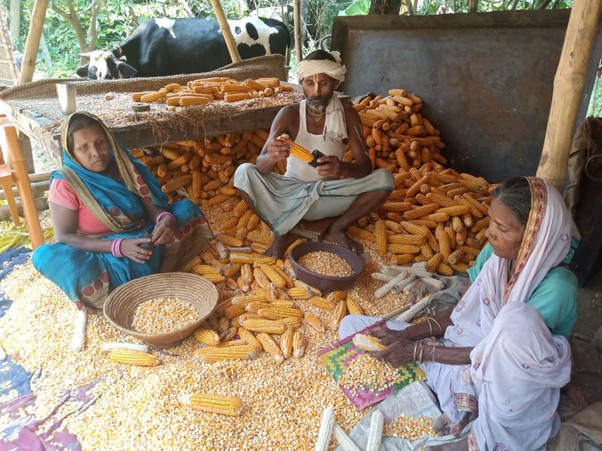Enhancing income of farmers through maize cultivation in Bihar

Hindustan, the leading newspaper of Bihar, reported in April 2021 that seven districts of Bihar have recorded the highest maize productivity in the world, approximately 50 quintals per acre. It has overtaken Indiana and Iowa, USA, in maize productivity. The Bihar government’s report states that maize acreage was 7.21 lakh hectare in 2016–17 out of a gross sown area of 78.82 lakh hectare. Maize cultivation provides livelihood to 1.3 million farmers of Bihar, most of whom are small and marginal farmers. The demand for maize has been fueled mainly by animal feed industries, modified corn starch facilities, and exports to South East Asia and Latin America. Farmers’ testimonials in areas of Bihar where Sehgal Foundation is working show that maize, if grown with appropriate package of practice, gives twice the income per acre in comparison to wheat. Hence, maize has the potential to enhance the income of 1.3 million maize farmers in Bihar, thereby significantly reducing poverty in one of the poorest states in India. Sehgal Foundation has worked with nearly 27,000 farmers since 2014 in selected villages of Muzaffarpur, Samastipur, Sitamarhi, and East Champaran districts of Bihar and trained them on good agricultural practices for maize and other crops. A number of training programs, field days, handholding support, and convergence with Krishi Vigyan Kendras (KVKs) were organized to guide farmers and address their queries on frequent problems. Farmers in the project locations before 2014 used the recommendations of shopkeepers for purchasing seeds, fertilizers, and pesticides; as a result, they ended up using twice the amounts of inputs required for the crops. This excess input use increased their cost of cultivation. In Sehgal Foundation project villages, farmers who were trained and guided started using optimal amounts of seeds, fertilizers, pesticides, and water in the crop. Farmers were interested in growing maize as it provided them good income. A large number of training programs and field days were conducted on a good package of practices for maize. The introduction of maize hybrid seeds tolerant to cold temperature had a significant positive impact on yield. In addition, use of climate-smart agricultural practices, such as zero-tillage machines for sowing of maize, helped in organic matter retention and saved labor, fuel, and time. Continuous demand for maize by animal feed industries located 50–60 kms from their villages in Muzaffarpur–Hajipur industrial cluster gave farmers the confidence that they will get good prices. Sehgal Foundation helped hundreds of farmers in the four districts, covering nearly 850 acres of land in growing maize.
One of the farmers, Ram Anurgrah Bhagat of Bhandari village, Sitamarhi district, says that he used to grow maize in 0.25 acre of his land, which used to give him produce of 4 quintals. He lacked the know-how, and did not have any guidance to increase the maize production. Upon a community leader’s advice, he joined the trainings Sehgal Foundation organized regularly for farmers in the village. He started attending the training in 2017 and was quite impressed that nearly thirty farmers were attending the training regularly and being provided with field level support from sowing to harvesting. As a consequence, he became confident and decided to plant maize in one acre of his land. His yield increased to nearly 40 quintals from that one acre of land. The market price of maize being nearly Rs 1,800–2,000 quintal per acre, he received Rs 72,000/ for his maize crop. He would have received Rs 36,000 only from the same field of wheat. So his income increased substantially by shifting to maize crop. A number of farmers of his village were closely monitoring his maize field, and some have started growing maize crop after taking his guidance. The cropping area of maize has increased by 10 percent in one year in the village.
Several farmers from the four districts mentioned above have similar success stories to share. Moreover, maize has more chances of success than wheat in varying climatic conditions, because wheat is more prone to biotic and abiotic stresses such as terminal heat stress. Overall, adoption of maize makes farmers less prone to financial and climatic risks. Ram adds, “More farmers will switch to maize if the wild boars and blue bulls (nilgai) are controlled.”
Some villages of Muzaffarpur and Sitamarhi district are facing a threat from wild boars and blue bulls that have a special liking for maize and are highly destructive, affecting several acres of maize crop in one night. As a result, some farmers left maize and started growing wheat. Government of Bihar framed rules in January 2022 that enable farmers to file complaints to the village council head if they are facing problems with wild boar and blue bulls. The head can request the Forest and Environment department to catch the animals. Obviously, such requests will face implementation challenges. The Forest Department has plans to sterilize blue bulls, targeting 5,000 blue bulls in 2022. Hopefully, these actions will help the farmers who grow maize, and they will have a good opportunity to increase their income. Simultaneously, the state government needs to keep up policy support activities, such as the promotion of local industries in Bihar for processing maize, and support traders to export, which will keep up the demand. Farmers will continue to grow maize as income enhancement is the big motivator for farmers who witnessed decreases in income over the years.
Source: Vikas Jha and Rahul Kumar,
v.jha@smsfoundation.org, r.kumar@smsfoundation.org